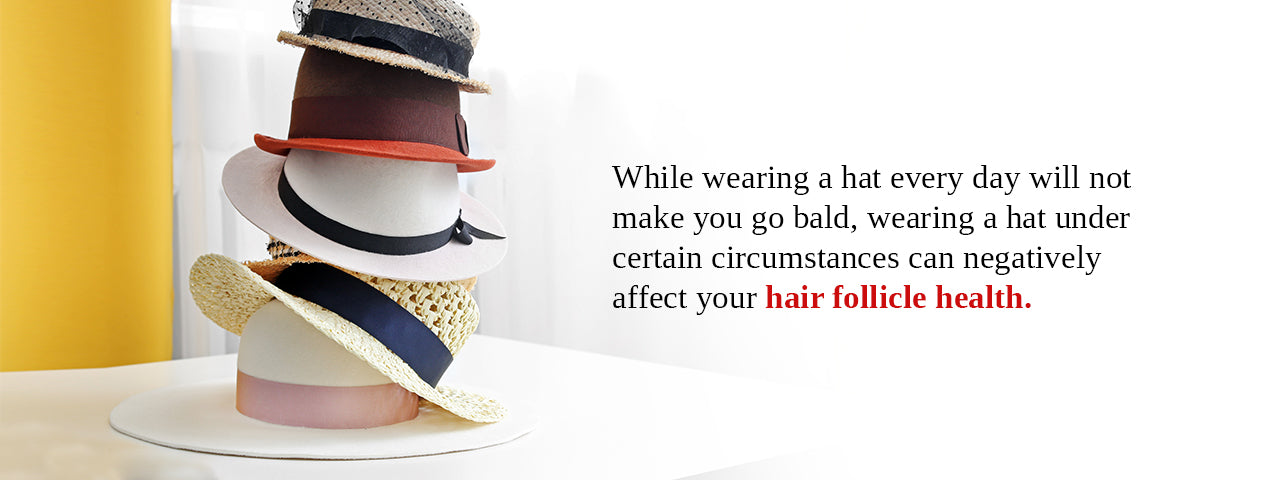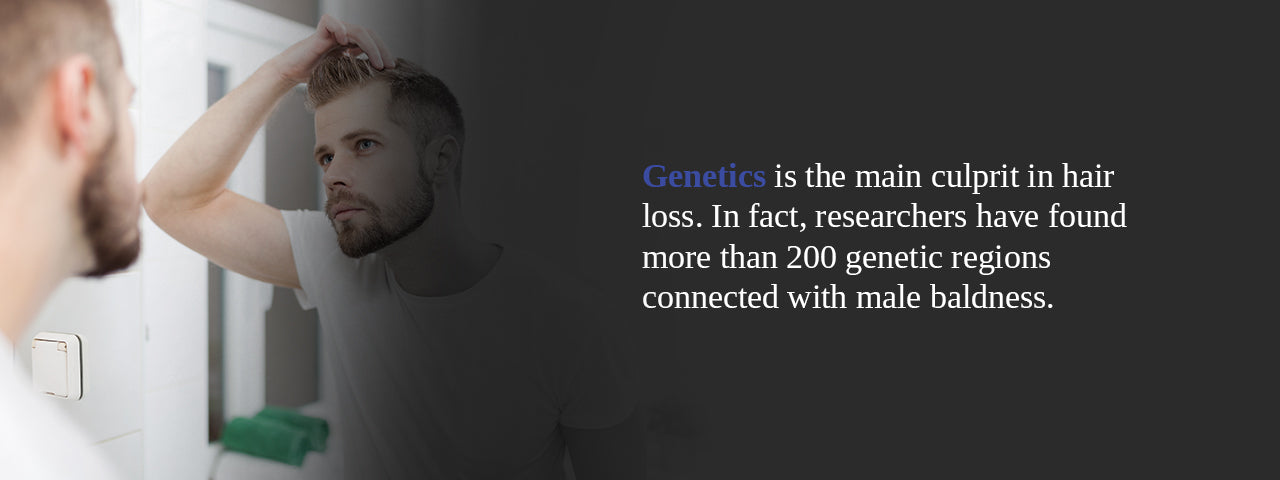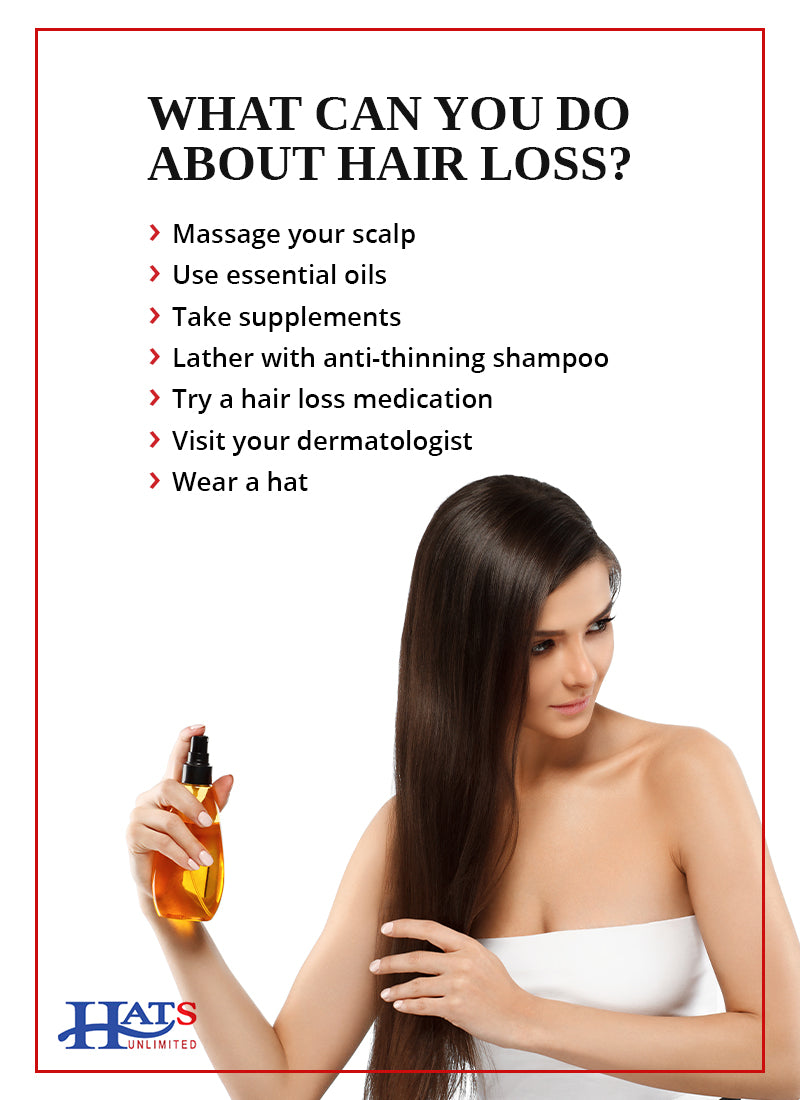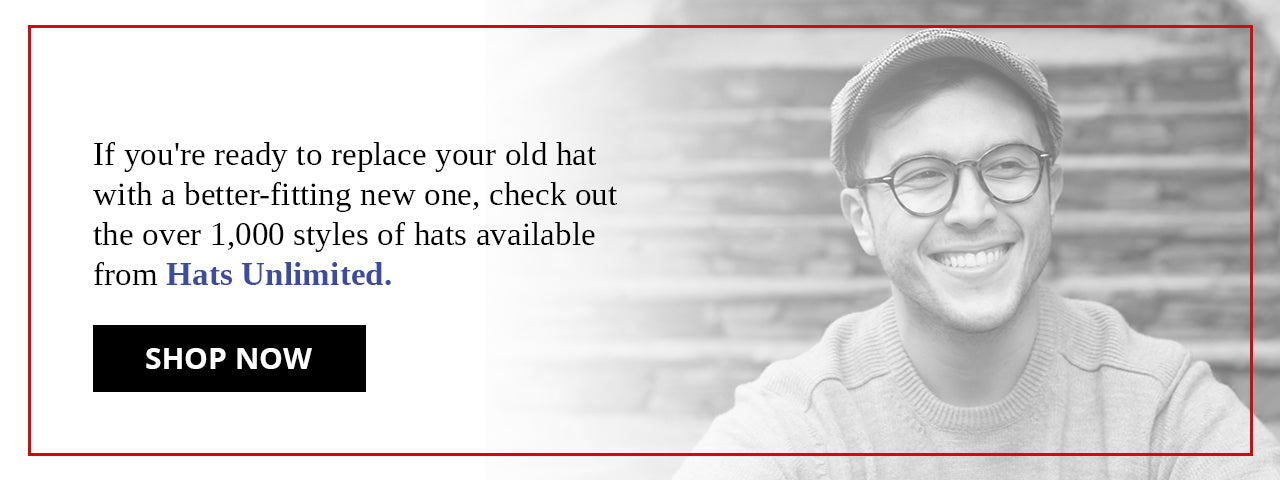No, Hats Don't Cause Hair Loss
We've all heard it said at some point that wearing a hat too often will make our hair fall out. After hearing this enough times, you may start to wonder whether wearing a hat is bad for your hair or whether your hat will cause hair loss. Can you go bald from wearing a hat, or is that just an old tale told to get youngsters to remove their hats?
In this article, we'll talk about whether wearing a hat makes you go bald, what does cause baldness, how to prevent hair loss and what to do to feel more comfortable with thinning hair. Keep reading to answer the age-old question of whether wearing a hat causes hair loss.

Does Wearing a Hat Cause Hair Loss?
Despite the widespread myths and misconceptions, wearing a hat does not cause hair loss or slow hair growth. In fact, assuming that wearing a hat causes hair loss seems to get the cause and effect backward. Many people who experience hair loss feel more comfortable wearing hats to hide their thinning hair, which may lead others to conclude that wearing the hat caused the baldness when that is probably not the case.
While wearing a hat every day will not make you go bald, wearing a hat under certain circumstances can negatively affect your hair follicle health. An extremely tight hat could restrict circulation to the hair follicles, which could contribute to hair loss. However, most people do not wear a hat tight enough to create the tension needed to cause hair follicle damage.
Even those who like to wear their hats more snugly are most likely not causing their hair to fall out. Because there are so many factors that contribute to baldness, wearing a tight hat isn't enough to cause hair loss on its own. So if you take your hat off and notice a few strands of hair left behind, there's no need to be alarmed.
If you want to minimize the risk of thinning hair as much as you can, make sure all your hats are well-fitted for your head shape. While tightness may be subjective, your hat should not leave a prominent mark or skin indentation on your forehead after you take it off. To avoid this problem, use a sizing chart whenever you're choosing new headwear.
If you're in between sizes, you can always size up and use hat sizing tape to size the hat back down if necessary.
Along with wearing a looser hat, try to keep your hats as clean as possible to avoid hair damage. Dust, dirt and bacteria can build up on an unwashed or old hat, which can irritate your scalp. Instead of relying on your old baseball cap from high school, find a new favorite hat and keep it clean — your hair will thank you.
Are There Benefits to Wearing a Hat?
Now that you know wearing a hat does not cause hair loss, the question becomes whether wearing a hat offers any benefits. And the answer is a resounding yes! A hat offers its wearer multiple advantages.
Here are the top five ways a hat can benefit your head.
1. Shields You From the Sun
Many hat styles can protect you from the sun's damaging rays. Specifically, hats with a bill like baseball caps can shield your eyes from too much sun exposure, which can lead to issues like cataracts later in life. Wearing a hat during outdoor activities, such as fishing or skiing, can preserve your eye health.
In addition to helping your eyes, hats help protect your skin from sunburn. In some cases, the right headwear can save you from uncomfortable after-effects of sunburn such as blisters, itchiness and peeling. Too much direct exposure to the sun's rays can also increase the long-term risk of skin cancer. Wearing a hat designed for sun protection can help minimize this risk by providing ultraviolet protection.
2. Regulates Your Body Temperature
Whether it's cold or hot, a hat can help you maintain a comfortable internal temperature. In the winter, a warm knitted beanie can lock in your head's heat. Wearing a cozy hat that also covers your ears is especially important on chilly, windy winter days. By keeping your body temperature steady, a hat can help protect you from getting sick.
On the other hand, a hat made for warmer weather, such as a straw hat, is perfect for staying cool as the summer sun beats down. The hat's lightweight material provides precious shade without feeling heavy. With the right hat, you can soak up the sun without sweating through your shirt.
3. Protects You From the Elements
A hat can protect both your scalp and hair from harsh weather and the harm it can cause. Putting on a hat when it's raining, snowing or excessively windy will prevent your scalp from receiving the full force of the elements. The extra layer of protection that a hat provides can fend off skin damage like dry and cracked skin as well as hair breakage.
4. Enhances Your Outfit
Your hat can be a fashion statement. A felt fedora can add a touch of class to an outfit while a casual cowboy hat can complete the rugged look. You can match your hat to the occasion as well. If you're going to the big game, wear a hat sporting your favorite team's logo.
From hipster slouchy hats to sideways snapbacks, hat trends change with each era. You can use a hat to keep up with what's popular or blaze your own trail with a unique look that expresses your personal style. Either way, your hat acts as an extension of your personality.
5. Rescues a Bad Hair Day
Bad hair day? Nothing a hat can't fix! Whether you woke up with bedhead, hate your new haircut, haven't washed your hair for a few days or can't seem to get a giant knot out of your hair, a hat can cover a multitude of hair mishaps.
Luckily, hats are widely acceptable in most social settings so they can be a sneaky way of concealing a bad hair day without raising suspicion. Next time your locks look less than presentable, trust a hat to get you out of a hairy situation.
What Actually Contributes to Hair Loss?
If wearing a hat doesn't cause hair loss, then what makes you go bald? Several factors can contribute to hair loss and hair thinning. Specifically, three variables affect hair loss the most — genetics, age and lifestyle.
This section will explore those three main variables further.
1. Genetics
Genetics is the main culprit in hair loss. In fact, researchers have found more than 200 genetic regions connected with male baldness. For this reason, inheriting genes tied to hair loss from one or both parents leads to a higher chance of balding or hair thinning.

The condition known as androgenetic alopecia, or pattern hair loss, is largely due to an inherited genetic sensitivity to the hormone dihydrotestosterone (DHT), which miniaturizes hair follicles. A sensitivity to DHT means that the hair follicles shrink in response to DHT, causing hair thinning and eventual loss.
DHT sensitivity can result in male-pattern baldness, which refers to when a man's hair recedes at the temples, creating an M-shaped hairline. However, women can also experience hormone-related hair loss, known as female-pattern baldness. Women with female-pattern hair loss may notice a widening of their center hair part or coarser hair on their face due to an inherited DHT sensitivity.
2. Age
Hair loss and hair thinning are quite common in older people. Although our cells grow and die continually throughout all phases of life, our cells begin to die more quickly than they regenerate as we get older. Because hair thinning is a part of the natural aging process, nearly everyone experiences some degree of hair loss as they age.
As we advance in years, we also start producing less oil in our scalp, which can make our hair weaker and more brittle. Weakened hair can lead to more hair breakage, contributing to overall hair thinning and loss.
3. Lifestyle
Numerous lifestyle choices and habits can affect the health of our hair. Some of the key causes of hair loss include the following practices:
- Using harsh styling products: Due to the chemicals they contain, certain hair products, such as extreme-hold gels and hair sprays, can harm your hair.
- Over-treating your hair: Regular color treatments, perms, relaxers and other styling methods typically involve applying intense heat to the hair, which can dry it out and cause hair loss over time.
- Putting your hair up too tightly: Pulling your hair up into a ponytail or tying it in tight braids may result in thin spots over time. Hairstyles that involve heat treatment, such as blow-drying it and straightening or curling it with an iron, can also cause damage.
- Smoking: Several studies have indicated that smoking can lead to premature hair loss because of the toxins cigarettes contain.
- Eating a nutrient-deficient diet: Not getting enough of the nutrients essential for natural hair follicle production, such as iron, protein and folic acid, can result in hair loss. On the other hand, getting too much vitamin A in your diet can cause hair to fall out. Fortunately, cutting the excess vitamin A out of your diet can easily reverse hair loss.
- Being overly stressed: Uncontrolled stress can trigger an increase of hormones like cortisol, which may kill off new hairs trying to grow from hair follicles. Both physical and mental stress can lead to stunted hair growth and shedding.
- Taking certain medications: Certain types of medications can promote hair loss. Most notably, certain blood-pressure drugs and blood thinners have been known to cause hair loss.

What Can You Do About Hair Loss?
While genetics and the aging process are out of our control, we can change our lifestyle choices to nurture healthier hair. Changing certain habits or picking up new practices may result in more luscious locks. If you've started noticing some thinner patches on your head, follow these top seven tips for dealing with hair loss:
- Massage your scalp: One of the most inexpensive and easiest ways to get thicker hair is to give yourself a scalp massage. While washing your hair, gently use your fingertips to apply extra pressure around your scalp, which encourages blood flow for increased hair growth.
- Use essential oils: Essential oils are liquids derived from plants that are commonly used in alternative medicine practices. Some of the best essential oils for preventing hair loss include lavender, peppermint and rosemary because they each contain properties that may stimulate hair growth.
- Take supplements: If you suspect your hair loss is due to a dietary deficiency, try taking a multivitamin or a more specific supplement to provide the key nutrients your body needs to generate strong hair. Folic acid supplements, biotin and essential fatty acids like omega-3 have all been linked to healthier hair. Be sure to consult with your doctor before adjusting your daily vitamins and supplements.
- Lather with anti-thinning shampoo: Anti-thinning shampoo can help your hair both appear fuller and start to grow thicker. Anti-thinning shampoo gives the hair you already have a volume boost so it looks thicker and delivers nourishing ingredients to the scalp so you can grow new hair over time.
- Try a hair loss medication: These days, there is a wide variety of hair loss prevention products that are available as over-the-counter medications. Most of these products are designed to regulate hormones to promote hair growth. Make sure you find a hair loss treatment approved by the U.S. Food and Drug Administration (FDA) so you can be confident it's safe.
- Visit your dermatologist: For a professional opinion about hair thinning and baldness, you may want to see a dermatologist. Your dermatologist will examine your scalp and determine the best hair loss therapy for you.
- Wear a hat: Putting on a stylish hat is the perfect solution for covering thinning hair or a bald spot. Many at-home treatments for hair loss are unreliable and may not produce results but you can always count on hats as an effective and fashionable way to disguise hair loss.
Replace Your Old Hat With a Fresh New One From Hats Unlimited!
If you're ready to replace your old hat with a better-fitting new one, check out the over 1,000 styles of hats available from Hats Unlimited. At Hats Unlimited, we have the perfect hat for every occasion and every head. From warm winter hats to cool summer caps, we've got your head covered.

If you don't see sizing information posted for the hat you're interested in, the friendly staff at Hats Unlimited is happy to provide you with specific measurements for the hat. You can also check out our official hat sizing guide for more helpful measurement tips.
Shop online or visit one of our store locations to find the best fitting hat for you today.


